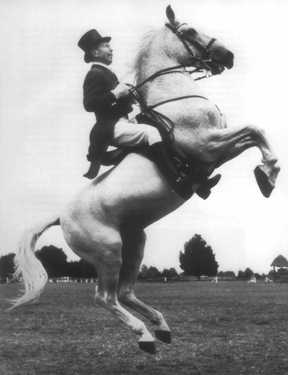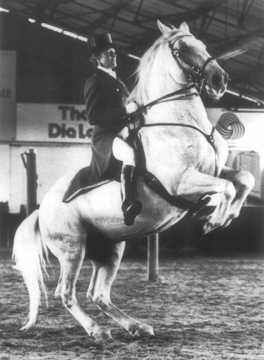 The History of the Lipizzaner
in South Africa
The History of the Lipizzaner
in South Africa The History of the Lipizzaner
in South Africa
The History of the Lipizzaner
in South Africa
The Lipizzaner Centre, at 1, Dahlia Road, Kyalami, was founded in the 1950's by Major Georg Iwanowski, a former officer of the Polish Lancers. The original horses were those brought to South Africa by Count Jankovich-Besan.
In the Austro-Hungarian Empire, many noblemen bred Lipizzaners, including the family of Count Jankovich-Besan at their estate, Oreglak. In 1944 when the Russain Army advanced West, Count Jankovich fled Hungary with a few of his precious Lipizzaners. They made their journey through bitter cold and dangerous conditions, the horses were painted with oil and paraffin to prevent them being requisitioned as food for troops. In 1946 the Count and his horses arrived safely in England, where they remained and Lord Digby's estate in Dorset until 1948 when they left for South Africa and made their new home in the green pastures of peaceful Natal.
Major Iwanowski left Poland after the Second World War, and arrived in South Africa in 1948. His career in South Africa began with a temporary job at a stud farm in the Karoo. After this, he went to Johannesburg to found Centaur Stables, a successful Equestrian Centre, near Sandown, which later became the first home of the Lipizzaner team.
At the Royal Agricultural Show in Pietermaritzburg, Major Iwanowski met Count Jankovich-Besan, who gave him the first Lipizzaner stallion that he was to own, Maestoso Erdem. It was Major Iwanowski's relationship with this special Lipizzaner that was the foundation of the Lipizzaner Team.
Major Iwanowski trained Erdem, and together they won the South African Dressage championship six times. The Lipizzaner team began when some of Major Iwanowski's pupils bought their own stallions from Count Jankovich, and in 1957 the first performance of the Lipizzaner team took place at the Rand Easter Show. The team consisted of four horses and riders. From this humble beginning the team grew, giving regular performances at Agricultural shows, until the South African Lipizzaner Centre was formed. Major Iwanowski also had plans for the breeding of Lipizzaners in South Africa, and the preservation of Count Jankovich's stud farm. Today, the Lipizzaner Centre houses some thirty two stallions, and at the National Lipizzaner stud in Natal there are approximately one hundred and twenty mares and foals.
Major Iwanowski formed a close alliance with the Spanish
Riding School in Vienna, beginning in 1957 when he met Colonel
Hans  Handler, who was
the first to give instruction to the then embryonic team. Since
then, Bereiter Ernst Bachinger, the late Oberbereiter Ignaz
Lauscha, and Bereiter Hubert Eichinger have all instructed the
team over the years. The longest alliance was with the remarkable
Oberbereiter Lauscha, whose gift for the airs above the ground is
yet unsurpassed. He trained the team for more than fifteen years.
Today the team is trained by the young and enthusiastic Bereiter
Andreas Hausberger.
Handler, who was
the first to give instruction to the then embryonic team. Since
then, Bereiter Ernst Bachinger, the late Oberbereiter Ignaz
Lauscha, and Bereiter Hubert Eichinger have all instructed the
team over the years. The longest alliance was with the remarkable
Oberbereiter Lauscha, whose gift for the airs above the ground is
yet unsurpassed. He trained the team for more than fifteen years.
Today the team is trained by the young and enthusiastic Bereiter
Andreas Hausberger.
National Chemical Products was the first sponsor for the team, and this allowed the stallions to take up residence at the Lipizzaner Centre in Kyalami. To begin with, the NCP Lipizzaner team gave monthly performances in an outdoor arena, as well as the public performances at National shows. The stud farm was established in Natal, with new blood being brought from Austria to prevent inbreeding and improve the lines. It was decided that the colts were to be sent for their formal training to Kyalami and the mares were to remain on the stud farm. Only proven stallions were to be used for breeding.
The team was growing, and some of South Africa's most talented young riders were keen to become a part of it. Major Iwanowski held morning training sessions at Kyalami, and being an ex-army man, discipline was rigorous. Every year an instructor from the world-famous Spanish Riding School in Vienna visited to train the South African Lipizzaners. Some of the riders in later years were to go to Vienna as pupils, and bring their knowledge back to White horses in Kyalami. The riders learnt about Haute Ecole, and eventually there were stallions in South Africa performing the most advanced movements of Capriole and Courbette.
In 1974 Sentrachem took over sponsorship of the now flourishing team, and performances took place every Sunday at 11am. This tradition continues. After Sentrachem withdrew their sponsorship, Simba chips and Total South Africa took their place and in 1992, probably for political reasons, this sponsorship was also withdrawn.
Today the Lipizzaner Centre is without a major sponsor, and survives due to the hard work of those dedicated to preserving this age-old art of classical horsemanship. The horses are kept in a Trust, and money is raised through performances, donations, and the work of the Friends of the Lipizzaners, a charity organisation whose sole motive is to keep alive this noble breed. Various Sponsorship and Patrons programmes are available for those who wish to help keep this noble breed alive.
The National Lipizzaner stud, in Natal, is dedicated to breeding only the finest stock of pure Lipizzaner and the breeding principles are those of the Austrian National Stud at Piber. The current director of the Spanish Riding School, Dr Ohlehla, oversees the breeding in South Africa. Over the years stallions have been imported both from Piber and from Yugoslavia, to ensure that the breeding of only the finest horses takes place.
The Lipizzaner Centre in South Africa is an oasis in the chaos of the world today, where old-fashioned values of dignity and nobility are upheld, and the pursuit of something high and aristocratic is reminiscent of the glorious times of The Royal Courts in Europe.